Binghamton University Thesis: Online Grocery Feasibility in Manhattan
VerifiedAdded on 2022/02/17
|32
|7430
|61
Thesis and Dissertation
AI Summary
This thesis, submitted to Binghamton University in Spring 2010, conducts a geospatial marketing analysis to determine the feasibility of online grocery shopping and delivery in Manhattan. The research delves into the history of grocery stores, the evolution of online grocery platforms, and the demographics of online shoppers. It examines variables affecting consumer behavior, including gender and income, and their impact on online purchasing decisions. The study utilizes census data and geospatial analysis techniques to assess market potential, considering factors like warehousing, truck routing, and the distribution of grocery stores in Manhattan. The thesis explores the challenges and opportunities of online grocery services, providing insights into consumer adoption, market segmentation, and the competitive landscape. The analysis includes detailed figures and tables, offering a comprehensive overview of the research methodology, data analysis, and key findings related to the viability and potential success of online grocery businesses in the urban environment of Manhattan.
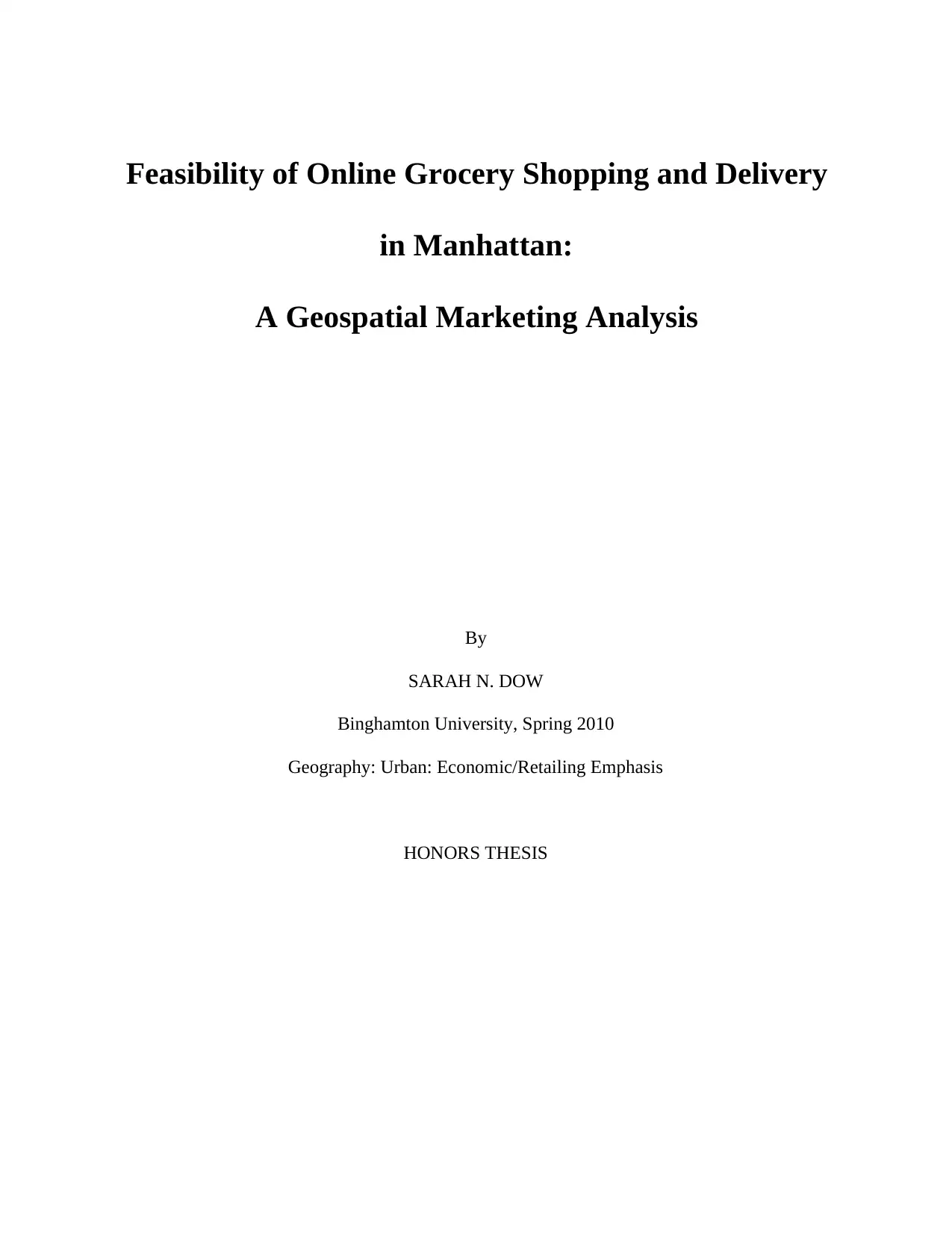
Feasibility of Online Grocery Shopping and Delivery
in Manhattan:
A Geospatial Marketing Analysis
By
SARAH N. DOW
Binghamton University, Spring 2010
Geography: Urban: Economic/Retailing Emphasis
HONORS THESIS
in Manhattan:
A Geospatial Marketing Analysis
By
SARAH N. DOW
Binghamton University, Spring 2010
Geography: Urban: Economic/Retailing Emphasis
HONORS THESIS
Paraphrase This Document
Need a fresh take? Get an instant paraphrase of this document with our AI Paraphraser
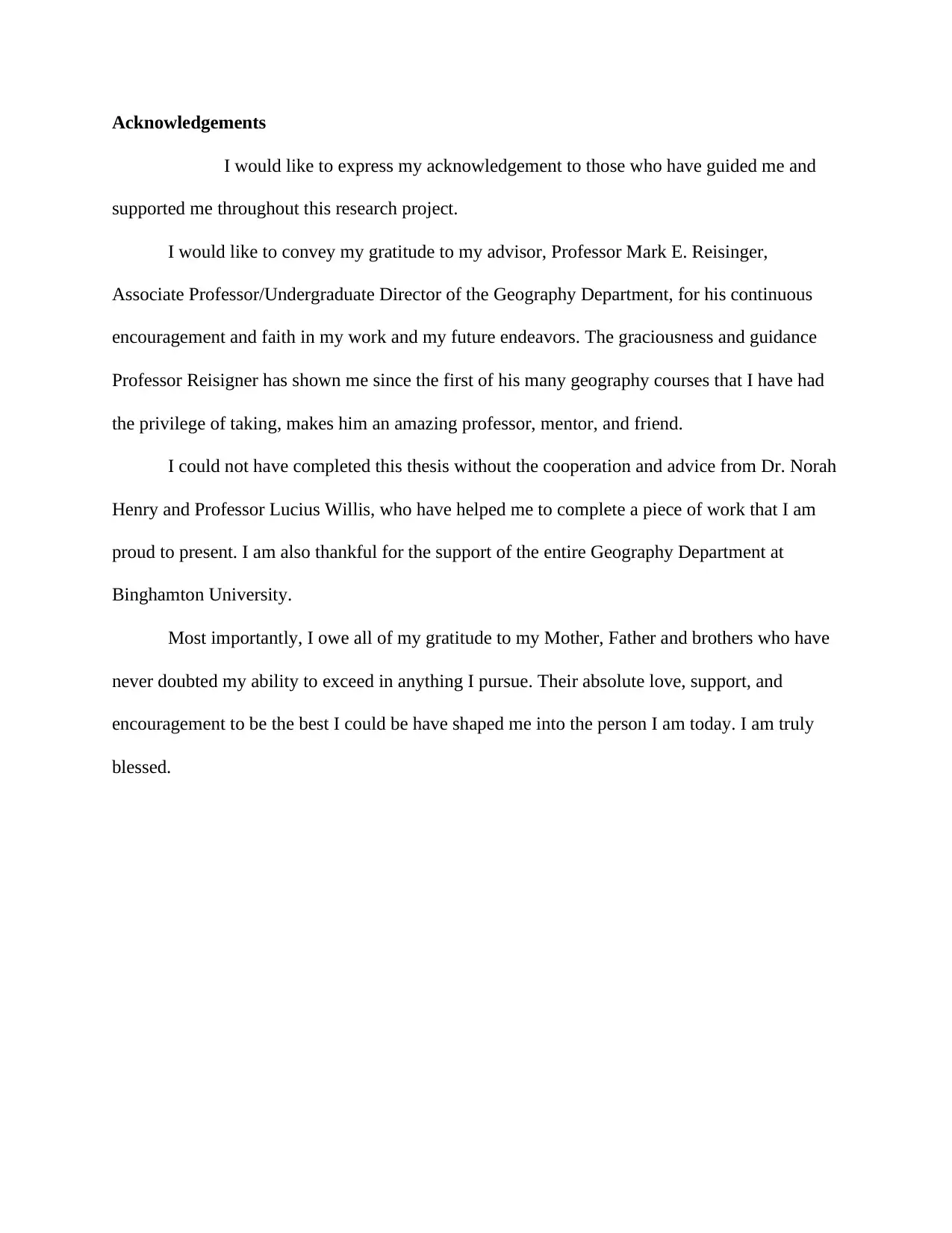
Acknowledgements
I would like to express my acknowledgement to those who have guided me and
supported me throughout this research project.
I would like to convey my gratitude to my advisor, Professor Mark E. Reisinger,
Associate Professor/Undergraduate Director of the Geography Department, for his continuous
encouragement and faith in my work and my future endeavors. The graciousness and guidance
Professor Reisigner has shown me since the first of his many geography courses that I have had
the privilege of taking, makes him an amazing professor, mentor, and friend.
I could not have completed this thesis without the cooperation and advice from Dr. Norah
Henry and Professor Lucius Willis, who have helped me to complete a piece of work that I am
proud to present. I am also thankful for the support of the entire Geography Department at
Binghamton University.
Most importantly, I owe all of my gratitude to my Mother, Father and brothers who have
never doubted my ability to exceed in anything I pursue. Their absolute love, support, and
encouragement to be the best I could be have shaped me into the person I am today. I am truly
blessed.
I would like to express my acknowledgement to those who have guided me and
supported me throughout this research project.
I would like to convey my gratitude to my advisor, Professor Mark E. Reisinger,
Associate Professor/Undergraduate Director of the Geography Department, for his continuous
encouragement and faith in my work and my future endeavors. The graciousness and guidance
Professor Reisigner has shown me since the first of his many geography courses that I have had
the privilege of taking, makes him an amazing professor, mentor, and friend.
I could not have completed this thesis without the cooperation and advice from Dr. Norah
Henry and Professor Lucius Willis, who have helped me to complete a piece of work that I am
proud to present. I am also thankful for the support of the entire Geography Department at
Binghamton University.
Most importantly, I owe all of my gratitude to my Mother, Father and brothers who have
never doubted my ability to exceed in anything I pursue. Their absolute love, support, and
encouragement to be the best I could be have shaped me into the person I am today. I am truly
blessed.
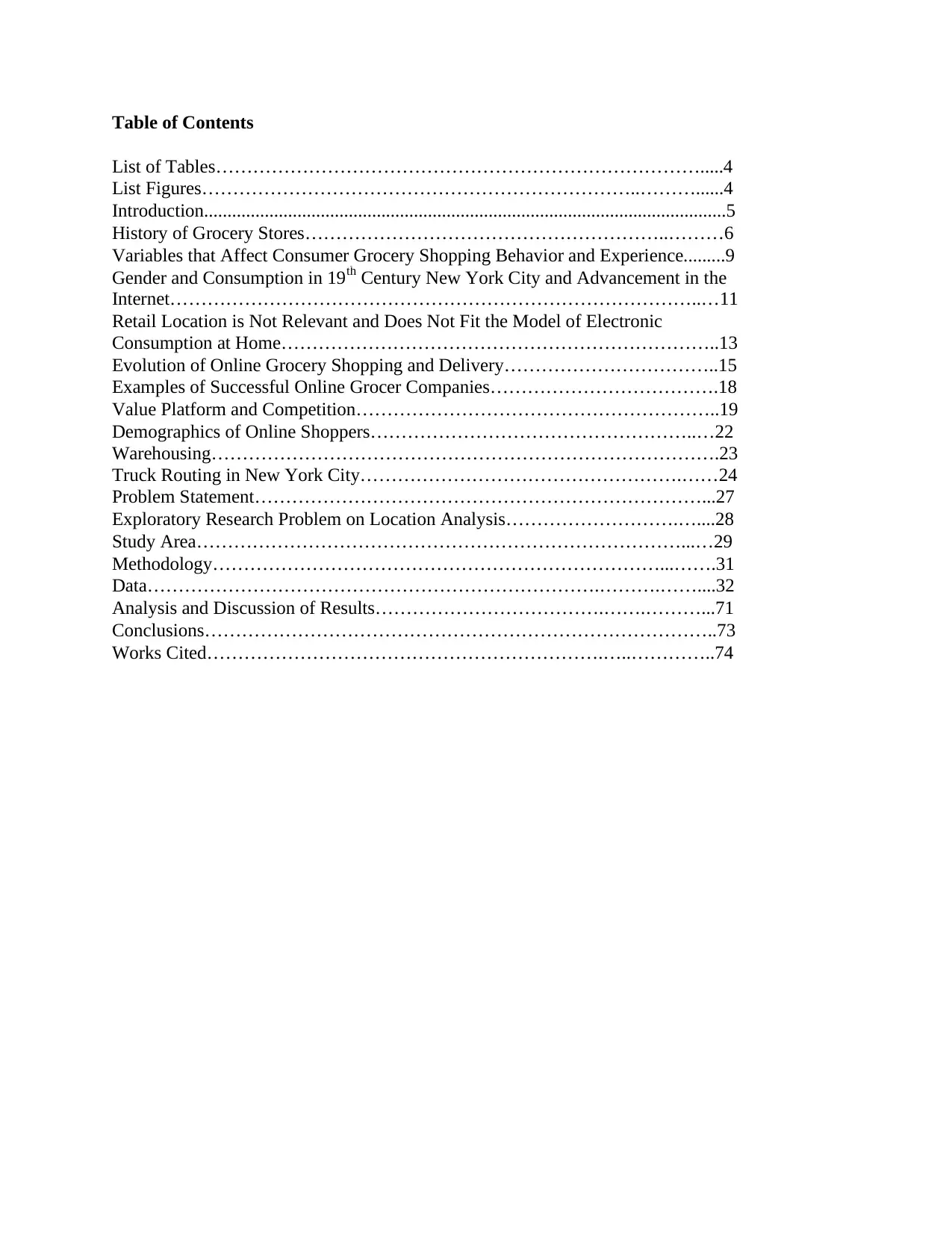
Table of Contents
List of Tables…………………………………………………………………….....4
List Figures……………………………………………………………..………......4
Introduction................................................................................................................5
History of Grocery Stores…………………………………………………..………6
Variables that Affect Consumer Grocery Shopping Behavior and Experience.........9
Gender and Consumption in 19th Century New York City and Advancement in the
Internet…………………………………………………………………………..…11
Retail Location is Not Relevant and Does Not Fit the Model of Electronic
Consumption at Home……………………………………………………………..13
Evolution of Online Grocery Shopping and Delivery……………………………..15
Examples of Successful Online Grocer Companies……………………………….18
Value Platform and Competition…………………………………………………..19
Demographics of Online Shoppers……………………………………………..…22
Warehousing……………………………………………………………………….23
Truck Routing in New York City…………………………………………….……24
Problem Statement………………………………………………………………...27
Exploratory Research Problem on Location Analysis……………………….…....28
Study Area……………………………………………………………………...…29
Methodology………………………………………………………………...…….31
Data……………………………………………………………….……….……....32
Analysis and Discussion of Results……………………………….…….………...71
Conclusions………………………………………………………………………..73
Works Cited……………………………………………………….…..…………..74
List of Tables…………………………………………………………………….....4
List Figures……………………………………………………………..………......4
Introduction................................................................................................................5
History of Grocery Stores…………………………………………………..………6
Variables that Affect Consumer Grocery Shopping Behavior and Experience.........9
Gender and Consumption in 19th Century New York City and Advancement in the
Internet…………………………………………………………………………..…11
Retail Location is Not Relevant and Does Not Fit the Model of Electronic
Consumption at Home……………………………………………………………..13
Evolution of Online Grocery Shopping and Delivery……………………………..15
Examples of Successful Online Grocer Companies……………………………….18
Value Platform and Competition…………………………………………………..19
Demographics of Online Shoppers……………………………………………..…22
Warehousing……………………………………………………………………….23
Truck Routing in New York City…………………………………………….……24
Problem Statement………………………………………………………………...27
Exploratory Research Problem on Location Analysis……………………….…....28
Study Area……………………………………………………………………...…29
Methodology………………………………………………………………...…….31
Data……………………………………………………………….……….……....32
Analysis and Discussion of Results……………………………….…….………...71
Conclusions………………………………………………………………………..73
Works Cited……………………………………………………….…..…………..74
⊘ This is a preview!⊘
Do you want full access?
Subscribe today to unlock all pages.

Trusted by 1+ million students worldwide
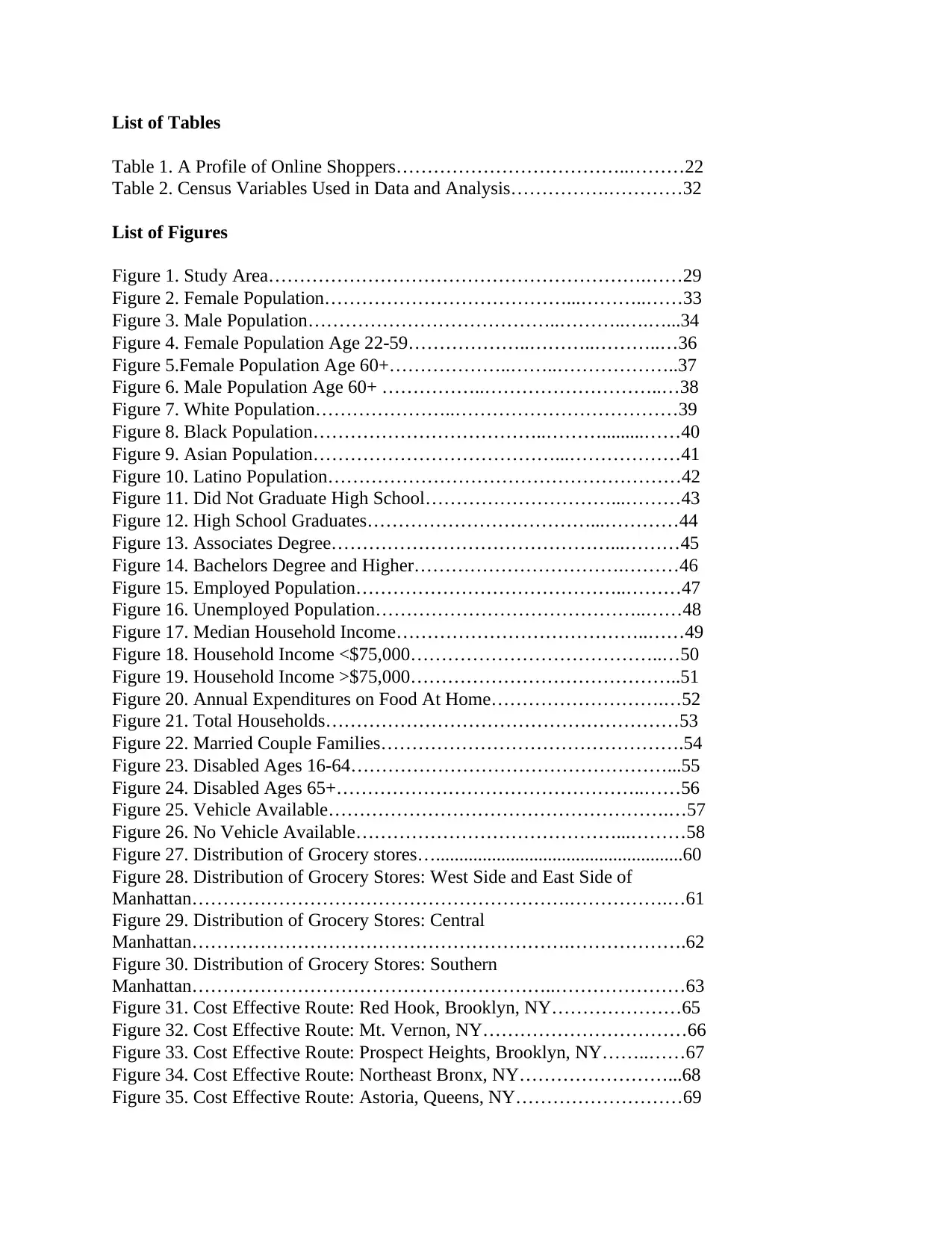
List of Tables
Table 1. A Profile of Online Shoppers………………………………..………22
Table 2. Census Variables Used in Data and Analysis…………….…………32
List of Figures
Figure 1. Study Area…………………………………………………….……29
Figure 2. Female Population…………………………………...………..……33
Figure 3. Male Population…………………………………..………..….…...34
Figure 4. Female Population Age 22-59………………..………..………..…36
Figure 5.Female Population Age 60+………………..……..………………..37
Figure 6. Male Population Age 60+ ……………..………………………..…38
Figure 7. White Population…………………..………………………………39
Figure 8. Black Population………………………………..……….........……40
Figure 9. Asian Population…………………………………...………………41
Figure 10. Latino Population…………………………………………………42
Figure 11. Did Not Graduate High School…………………………...………43
Figure 12. High School Graduates………………………………...…………44
Figure 13. Associates Degree………………………………………...………45
Figure 14. Bachelors Degree and Higher…………………………….………46
Figure 15. Employed Population……………………………………..………47
Figure 16. Unemployed Population……………………………………..……48
Figure 17. Median Household Income…………………………………..……49
Figure 18. Household Income <$75,000…………………………………..…50
Figure 19. Household Income >$75,000……………………………………..51
Figure 20. Annual Expenditures on Food At Home……………………….…52
Figure 21. Total Households…………………………………………………53
Figure 22. Married Couple Families………………………………………….54
Figure 23. Disabled Ages 16-64……………………………………………...55
Figure 24. Disabled Ages 65+…………………………………………..……56
Figure 25. Vehicle Available……………………………………………….…57
Figure 26. No Vehicle Available……………………………………...………58
Figure 27. Distribution of Grocery stores….....................................................60
Figure 28. Distribution of Grocery Stores: West Side and East Side of
Manhattan…………………………………………………….…………….…61
Figure 29. Distribution of Grocery Stores: Central
Manhattan…………………………………………………….……………….62
Figure 30. Distribution of Grocery Stores: Southern
Manhattan…………………………………………………..…………………63
Figure 31. Cost Effective Route: Red Hook, Brooklyn, NY…………………65
Figure 32. Cost Effective Route: Mt. Vernon, NY……………………………66
Figure 33. Cost Effective Route: Prospect Heights, Brooklyn, NY……..……67
Figure 34. Cost Effective Route: Northeast Bronx, NY……………………...68
Figure 35. Cost Effective Route: Astoria, Queens, NY………………………69
Table 1. A Profile of Online Shoppers………………………………..………22
Table 2. Census Variables Used in Data and Analysis…………….…………32
List of Figures
Figure 1. Study Area…………………………………………………….……29
Figure 2. Female Population…………………………………...………..……33
Figure 3. Male Population…………………………………..………..….…...34
Figure 4. Female Population Age 22-59………………..………..………..…36
Figure 5.Female Population Age 60+………………..……..………………..37
Figure 6. Male Population Age 60+ ……………..………………………..…38
Figure 7. White Population…………………..………………………………39
Figure 8. Black Population………………………………..……….........……40
Figure 9. Asian Population…………………………………...………………41
Figure 10. Latino Population…………………………………………………42
Figure 11. Did Not Graduate High School…………………………...………43
Figure 12. High School Graduates………………………………...…………44
Figure 13. Associates Degree………………………………………...………45
Figure 14. Bachelors Degree and Higher…………………………….………46
Figure 15. Employed Population……………………………………..………47
Figure 16. Unemployed Population……………………………………..……48
Figure 17. Median Household Income…………………………………..……49
Figure 18. Household Income <$75,000…………………………………..…50
Figure 19. Household Income >$75,000……………………………………..51
Figure 20. Annual Expenditures on Food At Home……………………….…52
Figure 21. Total Households…………………………………………………53
Figure 22. Married Couple Families………………………………………….54
Figure 23. Disabled Ages 16-64……………………………………………...55
Figure 24. Disabled Ages 65+…………………………………………..……56
Figure 25. Vehicle Available……………………………………………….…57
Figure 26. No Vehicle Available……………………………………...………58
Figure 27. Distribution of Grocery stores….....................................................60
Figure 28. Distribution of Grocery Stores: West Side and East Side of
Manhattan…………………………………………………….…………….…61
Figure 29. Distribution of Grocery Stores: Central
Manhattan…………………………………………………….……………….62
Figure 30. Distribution of Grocery Stores: Southern
Manhattan…………………………………………………..…………………63
Figure 31. Cost Effective Route: Red Hook, Brooklyn, NY…………………65
Figure 32. Cost Effective Route: Mt. Vernon, NY……………………………66
Figure 33. Cost Effective Route: Prospect Heights, Brooklyn, NY……..……67
Figure 34. Cost Effective Route: Northeast Bronx, NY……………………...68
Figure 35. Cost Effective Route: Astoria, Queens, NY………………………69
Paraphrase This Document
Need a fresh take? Get an instant paraphrase of this document with our AI Paraphraser
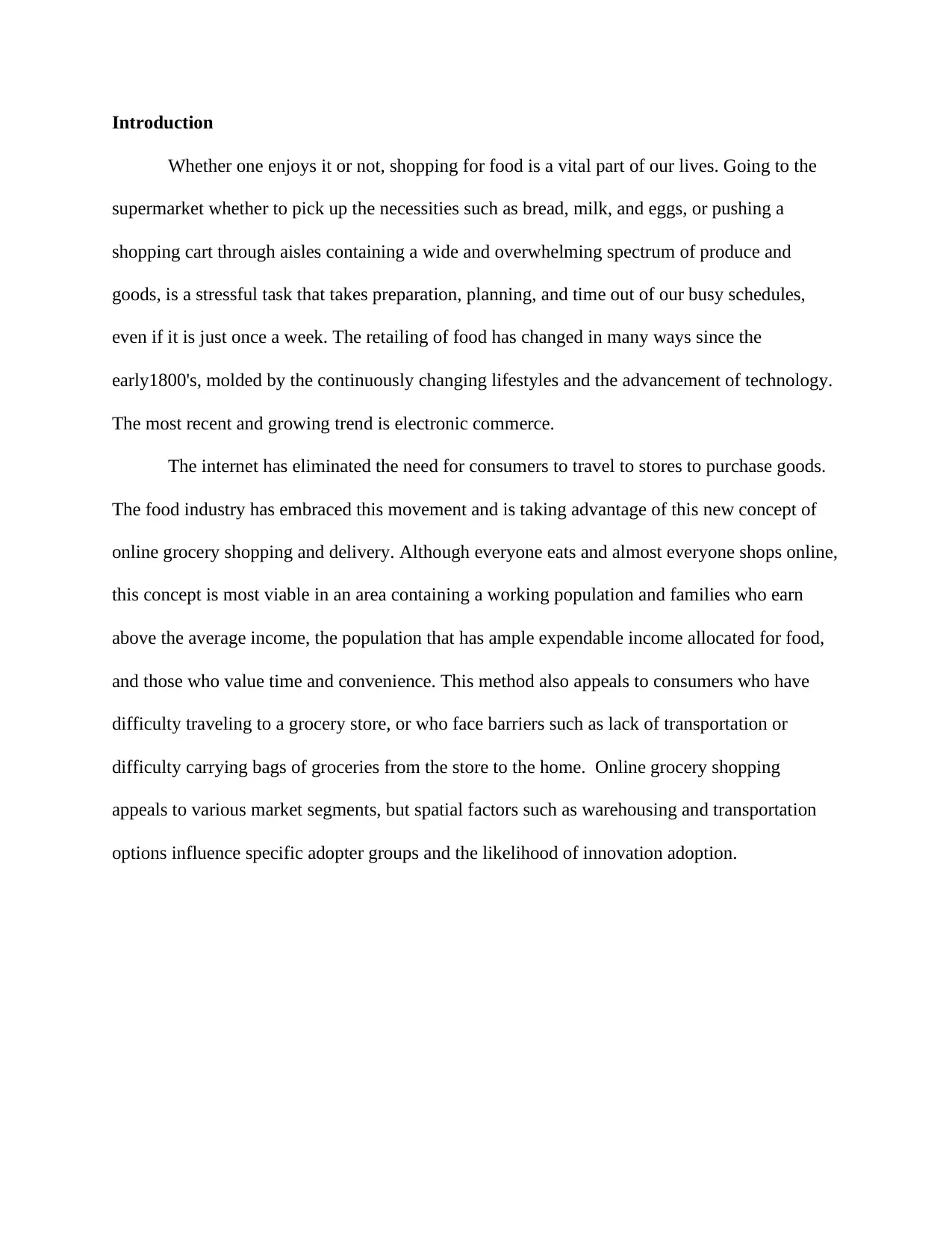
Introduction
Whether one enjoys it or not, shopping for food is a vital part of our lives. Going to the
supermarket whether to pick up the necessities such as bread, milk, and eggs, or pushing a
shopping cart through aisles containing a wide and overwhelming spectrum of produce and
goods, is a stressful task that takes preparation, planning, and time out of our busy schedules,
even if it is just once a week. The retailing of food has changed in many ways since the
early1800's, molded by the continuously changing lifestyles and the advancement of technology.
The most recent and growing trend is electronic commerce.
The internet has eliminated the need for consumers to travel to stores to purchase goods.
The food industry has embraced this movement and is taking advantage of this new concept of
online grocery shopping and delivery. Although everyone eats and almost everyone shops online,
this concept is most viable in an area containing a working population and families who earn
above the average income, the population that has ample expendable income allocated for food,
and those who value time and convenience. This method also appeals to consumers who have
difficulty traveling to a grocery store, or who face barriers such as lack of transportation or
difficulty carrying bags of groceries from the store to the home. Online grocery shopping
appeals to various market segments, but spatial factors such as warehousing and transportation
options influence specific adopter groups and the likelihood of innovation adoption.
Whether one enjoys it or not, shopping for food is a vital part of our lives. Going to the
supermarket whether to pick up the necessities such as bread, milk, and eggs, or pushing a
shopping cart through aisles containing a wide and overwhelming spectrum of produce and
goods, is a stressful task that takes preparation, planning, and time out of our busy schedules,
even if it is just once a week. The retailing of food has changed in many ways since the
early1800's, molded by the continuously changing lifestyles and the advancement of technology.
The most recent and growing trend is electronic commerce.
The internet has eliminated the need for consumers to travel to stores to purchase goods.
The food industry has embraced this movement and is taking advantage of this new concept of
online grocery shopping and delivery. Although everyone eats and almost everyone shops online,
this concept is most viable in an area containing a working population and families who earn
above the average income, the population that has ample expendable income allocated for food,
and those who value time and convenience. This method also appeals to consumers who have
difficulty traveling to a grocery store, or who face barriers such as lack of transportation or
difficulty carrying bags of groceries from the store to the home. Online grocery shopping
appeals to various market segments, but spatial factors such as warehousing and transportation
options influence specific adopter groups and the likelihood of innovation adoption.
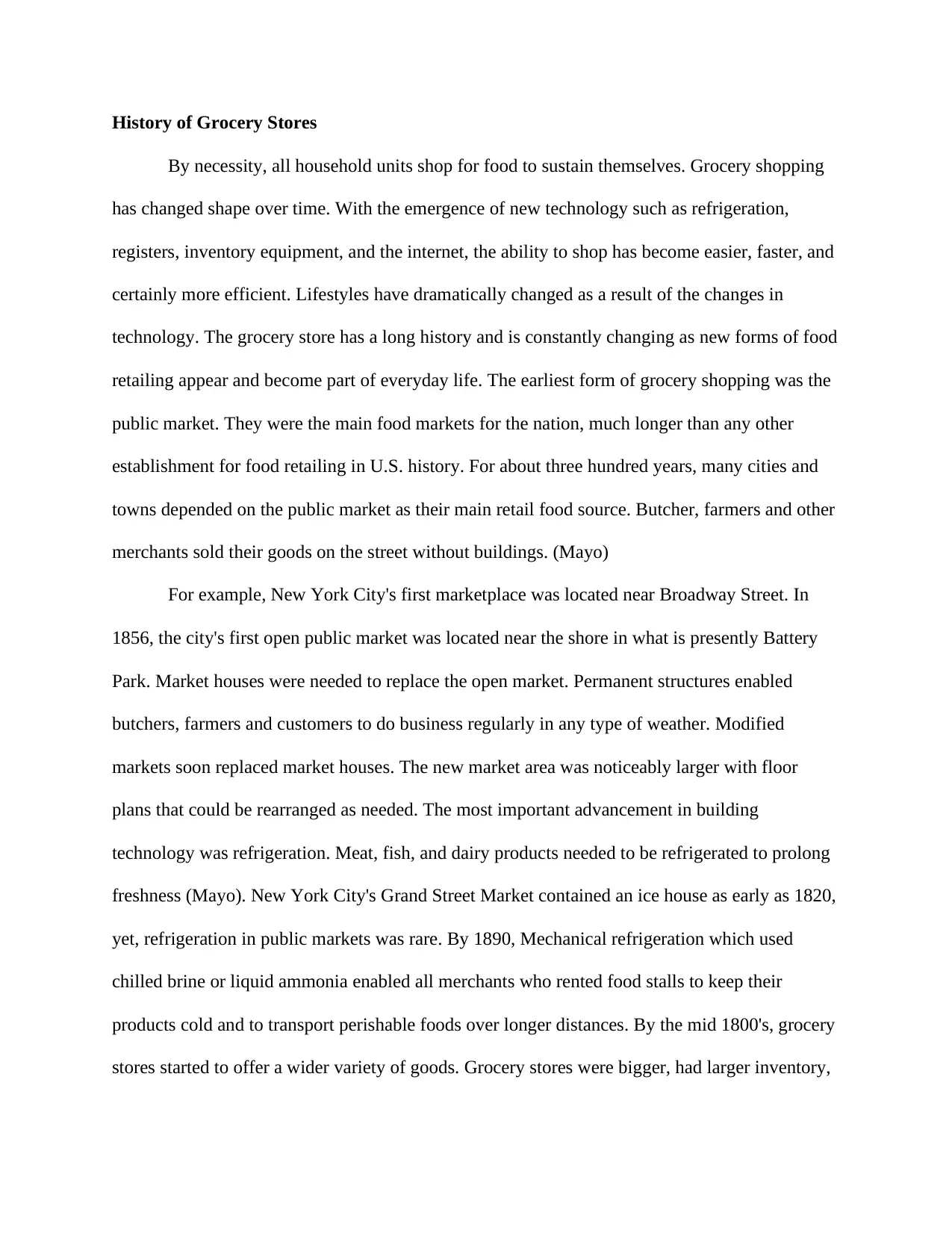
History of Grocery Stores
By necessity, all household units shop for food to sustain themselves. Grocery shopping
has changed shape over time. With the emergence of new technology such as refrigeration,
registers, inventory equipment, and the internet, the ability to shop has become easier, faster, and
certainly more efficient. Lifestyles have dramatically changed as a result of the changes in
technology. The grocery store has a long history and is constantly changing as new forms of food
retailing appear and become part of everyday life. The earliest form of grocery shopping was the
public market. They were the main food markets for the nation, much longer than any other
establishment for food retailing in U.S. history. For about three hundred years, many cities and
towns depended on the public market as their main retail food source. Butcher, farmers and other
merchants sold their goods on the street without buildings. (Mayo)
For example, New York City's first marketplace was located near Broadway Street. In
1856, the city's first open public market was located near the shore in what is presently Battery
Park. Market houses were needed to replace the open market. Permanent structures enabled
butchers, farmers and customers to do business regularly in any type of weather. Modified
markets soon replaced market houses. The new market area was noticeably larger with floor
plans that could be rearranged as needed. The most important advancement in building
technology was refrigeration. Meat, fish, and dairy products needed to be refrigerated to prolong
freshness (Mayo). New York City's Grand Street Market contained an ice house as early as 1820,
yet, refrigeration in public markets was rare. By 1890, Mechanical refrigeration which used
chilled brine or liquid ammonia enabled all merchants who rented food stalls to keep their
products cold and to transport perishable foods over longer distances. By the mid 1800's, grocery
stores started to offer a wider variety of goods. Grocery stores were bigger, had larger inventory,
By necessity, all household units shop for food to sustain themselves. Grocery shopping
has changed shape over time. With the emergence of new technology such as refrigeration,
registers, inventory equipment, and the internet, the ability to shop has become easier, faster, and
certainly more efficient. Lifestyles have dramatically changed as a result of the changes in
technology. The grocery store has a long history and is constantly changing as new forms of food
retailing appear and become part of everyday life. The earliest form of grocery shopping was the
public market. They were the main food markets for the nation, much longer than any other
establishment for food retailing in U.S. history. For about three hundred years, many cities and
towns depended on the public market as their main retail food source. Butcher, farmers and other
merchants sold their goods on the street without buildings. (Mayo)
For example, New York City's first marketplace was located near Broadway Street. In
1856, the city's first open public market was located near the shore in what is presently Battery
Park. Market houses were needed to replace the open market. Permanent structures enabled
butchers, farmers and customers to do business regularly in any type of weather. Modified
markets soon replaced market houses. The new market area was noticeably larger with floor
plans that could be rearranged as needed. The most important advancement in building
technology was refrigeration. Meat, fish, and dairy products needed to be refrigerated to prolong
freshness (Mayo). New York City's Grand Street Market contained an ice house as early as 1820,
yet, refrigeration in public markets was rare. By 1890, Mechanical refrigeration which used
chilled brine or liquid ammonia enabled all merchants who rented food stalls to keep their
products cold and to transport perishable foods over longer distances. By the mid 1800's, grocery
stores started to offer a wider variety of goods. Grocery stores were bigger, had larger inventory,
⊘ This is a preview!⊘
Do you want full access?
Subscribe today to unlock all pages.

Trusted by 1+ million students worldwide
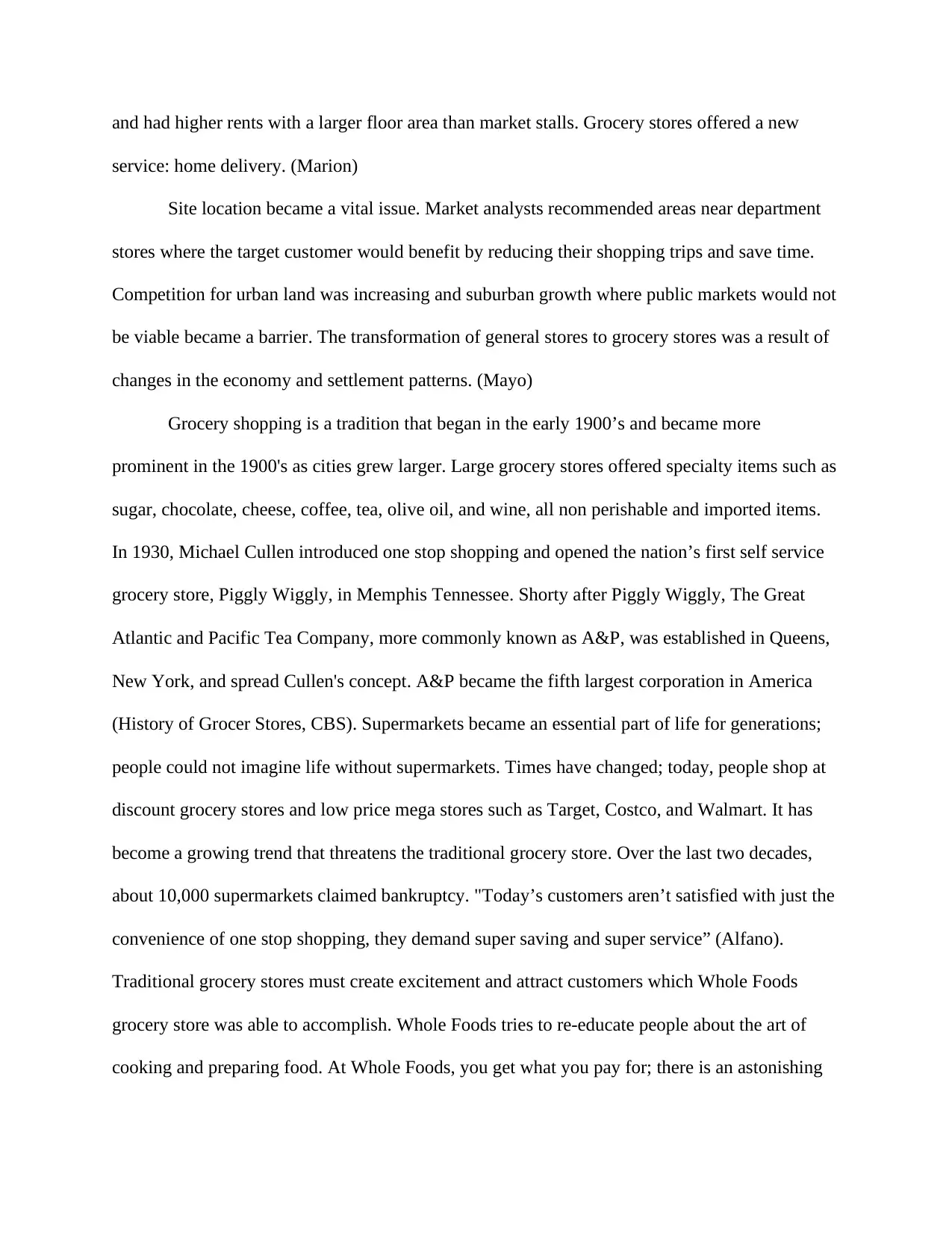
and had higher rents with a larger floor area than market stalls. Grocery stores offered a new
service: home delivery. (Marion)
Site location became a vital issue. Market analysts recommended areas near department
stores where the target customer would benefit by reducing their shopping trips and save time.
Competition for urban land was increasing and suburban growth where public markets would not
be viable became a barrier. The transformation of general stores to grocery stores was a result of
changes in the economy and settlement patterns. (Mayo)
Grocery shopping is a tradition that began in the early 1900’s and became more
prominent in the 1900's as cities grew larger. Large grocery stores offered specialty items such as
sugar, chocolate, cheese, coffee, tea, olive oil, and wine, all non perishable and imported items.
In 1930, Michael Cullen introduced one stop shopping and opened the nation’s first self service
grocery store, Piggly Wiggly, in Memphis Tennessee. Shorty after Piggly Wiggly, The Great
Atlantic and Pacific Tea Company, more commonly known as A&P, was established in Queens,
New York, and spread Cullen's concept. A&P became the fifth largest corporation in America
(History of Grocer Stores, CBS). Supermarkets became an essential part of life for generations;
people could not imagine life without supermarkets. Times have changed; today, people shop at
discount grocery stores and low price mega stores such as Target, Costco, and Walmart. It has
become a growing trend that threatens the traditional grocery store. Over the last two decades,
about 10,000 supermarkets claimed bankruptcy. "Today’s customers aren’t satisfied with just the
convenience of one stop shopping, they demand super saving and super service” (Alfano).
Traditional grocery stores must create excitement and attract customers which Whole Foods
grocery store was able to accomplish. Whole Foods tries to re-educate people about the art of
cooking and preparing food. At Whole Foods, you get what you pay for; there is an astonishing
service: home delivery. (Marion)
Site location became a vital issue. Market analysts recommended areas near department
stores where the target customer would benefit by reducing their shopping trips and save time.
Competition for urban land was increasing and suburban growth where public markets would not
be viable became a barrier. The transformation of general stores to grocery stores was a result of
changes in the economy and settlement patterns. (Mayo)
Grocery shopping is a tradition that began in the early 1900’s and became more
prominent in the 1900's as cities grew larger. Large grocery stores offered specialty items such as
sugar, chocolate, cheese, coffee, tea, olive oil, and wine, all non perishable and imported items.
In 1930, Michael Cullen introduced one stop shopping and opened the nation’s first self service
grocery store, Piggly Wiggly, in Memphis Tennessee. Shorty after Piggly Wiggly, The Great
Atlantic and Pacific Tea Company, more commonly known as A&P, was established in Queens,
New York, and spread Cullen's concept. A&P became the fifth largest corporation in America
(History of Grocer Stores, CBS). Supermarkets became an essential part of life for generations;
people could not imagine life without supermarkets. Times have changed; today, people shop at
discount grocery stores and low price mega stores such as Target, Costco, and Walmart. It has
become a growing trend that threatens the traditional grocery store. Over the last two decades,
about 10,000 supermarkets claimed bankruptcy. "Today’s customers aren’t satisfied with just the
convenience of one stop shopping, they demand super saving and super service” (Alfano).
Traditional grocery stores must create excitement and attract customers which Whole Foods
grocery store was able to accomplish. Whole Foods tries to re-educate people about the art of
cooking and preparing food. At Whole Foods, you get what you pay for; there is an astonishing
Paraphrase This Document
Need a fresh take? Get an instant paraphrase of this document with our AI Paraphraser

selection but a bit on the pricey side (History of Grocery Stores, CBS). Surviving grocery chains
are taking notions from high and low end competitors. Money saving customers are attracted to
"big box" discounters. Mass in mass marketing is a thing of the past. "They are getting better
prices at Walmart, they are getting better offerings because of people like Whole Foods. The
world of retailing is always evolving (Alfano)". According to Alfano, Americans average 2.3
trips to the supermarket each week, spending $24.64 a visit.
are taking notions from high and low end competitors. Money saving customers are attracted to
"big box" discounters. Mass in mass marketing is a thing of the past. "They are getting better
prices at Walmart, they are getting better offerings because of people like Whole Foods. The
world of retailing is always evolving (Alfano)". According to Alfano, Americans average 2.3
trips to the supermarket each week, spending $24.64 a visit.
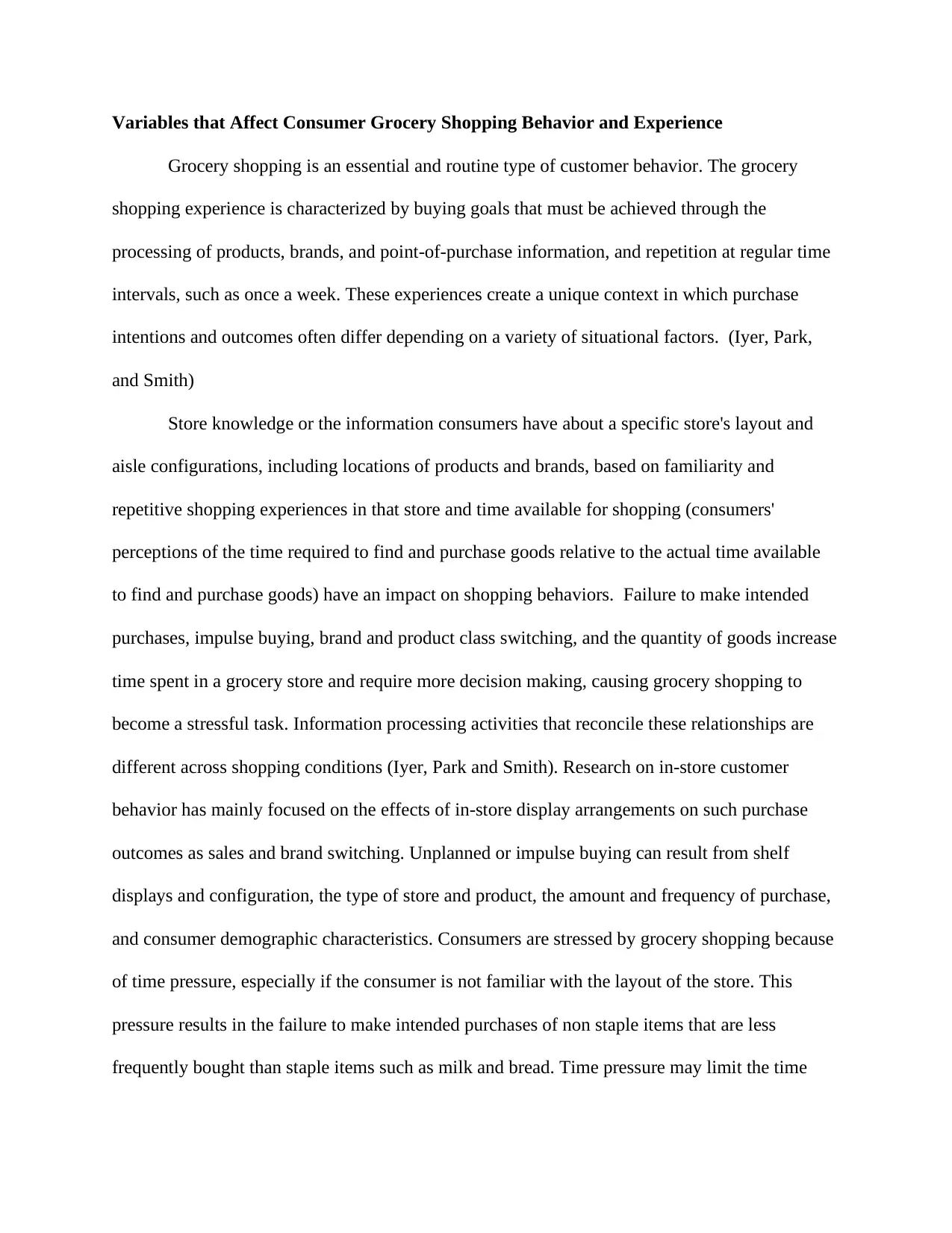
Variables that Affect Consumer Grocery Shopping Behavior and Experience
Grocery shopping is an essential and routine type of customer behavior. The grocery
shopping experience is characterized by buying goals that must be achieved through the
processing of products, brands, and point-of-purchase information, and repetition at regular time
intervals, such as once a week. These experiences create a unique context in which purchase
intentions and outcomes often differ depending on a variety of situational factors. (Iyer, Park,
and Smith)
Store knowledge or the information consumers have about a specific store's layout and
aisle configurations, including locations of products and brands, based on familiarity and
repetitive shopping experiences in that store and time available for shopping (consumers'
perceptions of the time required to find and purchase goods relative to the actual time available
to find and purchase goods) have an impact on shopping behaviors. Failure to make intended
purchases, impulse buying, brand and product class switching, and the quantity of goods increase
time spent in a grocery store and require more decision making, causing grocery shopping to
become a stressful task. Information processing activities that reconcile these relationships are
different across shopping conditions (Iyer, Park and Smith). Research on in-store customer
behavior has mainly focused on the effects of in-store display arrangements on such purchase
outcomes as sales and brand switching. Unplanned or impulse buying can result from shelf
displays and configuration, the type of store and product, the amount and frequency of purchase,
and consumer demographic characteristics. Consumers are stressed by grocery shopping because
of time pressure, especially if the consumer is not familiar with the layout of the store. This
pressure results in the failure to make intended purchases of non staple items that are less
frequently bought than staple items such as milk and bread. Time pressure may limit the time
Grocery shopping is an essential and routine type of customer behavior. The grocery
shopping experience is characterized by buying goals that must be achieved through the
processing of products, brands, and point-of-purchase information, and repetition at regular time
intervals, such as once a week. These experiences create a unique context in which purchase
intentions and outcomes often differ depending on a variety of situational factors. (Iyer, Park,
and Smith)
Store knowledge or the information consumers have about a specific store's layout and
aisle configurations, including locations of products and brands, based on familiarity and
repetitive shopping experiences in that store and time available for shopping (consumers'
perceptions of the time required to find and purchase goods relative to the actual time available
to find and purchase goods) have an impact on shopping behaviors. Failure to make intended
purchases, impulse buying, brand and product class switching, and the quantity of goods increase
time spent in a grocery store and require more decision making, causing grocery shopping to
become a stressful task. Information processing activities that reconcile these relationships are
different across shopping conditions (Iyer, Park and Smith). Research on in-store customer
behavior has mainly focused on the effects of in-store display arrangements on such purchase
outcomes as sales and brand switching. Unplanned or impulse buying can result from shelf
displays and configuration, the type of store and product, the amount and frequency of purchase,
and consumer demographic characteristics. Consumers are stressed by grocery shopping because
of time pressure, especially if the consumer is not familiar with the layout of the store. This
pressure results in the failure to make intended purchases of non staple items that are less
frequently bought than staple items such as milk and bread. Time pressure may limit the time
⊘ This is a preview!⊘
Do you want full access?
Subscribe today to unlock all pages.

Trusted by 1+ million students worldwide
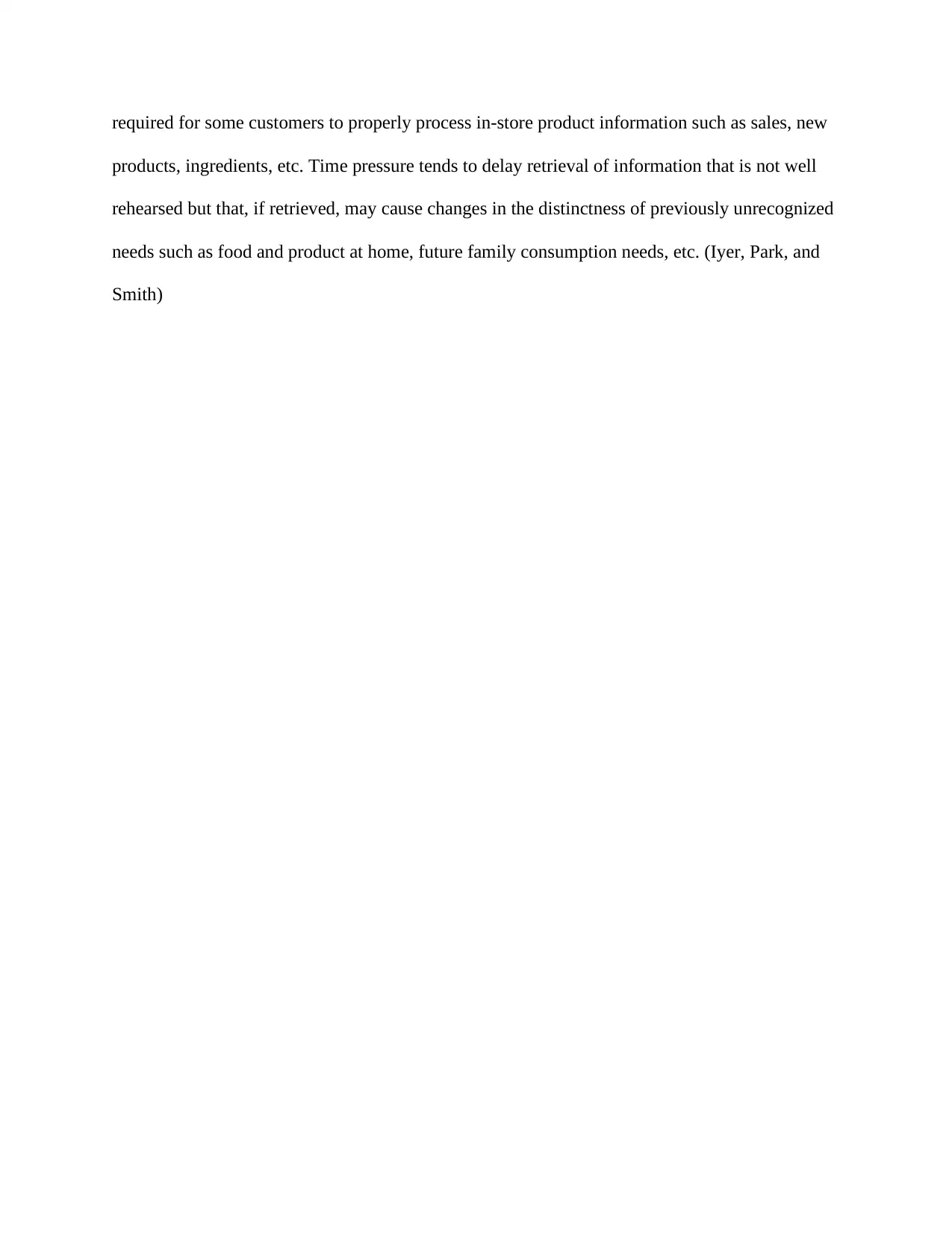
required for some customers to properly process in-store product information such as sales, new
products, ingredients, etc. Time pressure tends to delay retrieval of information that is not well
rehearsed but that, if retrieved, may cause changes in the distinctness of previously unrecognized
needs such as food and product at home, future family consumption needs, etc. (Iyer, Park, and
Smith)
products, ingredients, etc. Time pressure tends to delay retrieval of information that is not well
rehearsed but that, if retrieved, may cause changes in the distinctness of previously unrecognized
needs such as food and product at home, future family consumption needs, etc. (Iyer, Park, and
Smith)
Paraphrase This Document
Need a fresh take? Get an instant paraphrase of this document with our AI Paraphraser
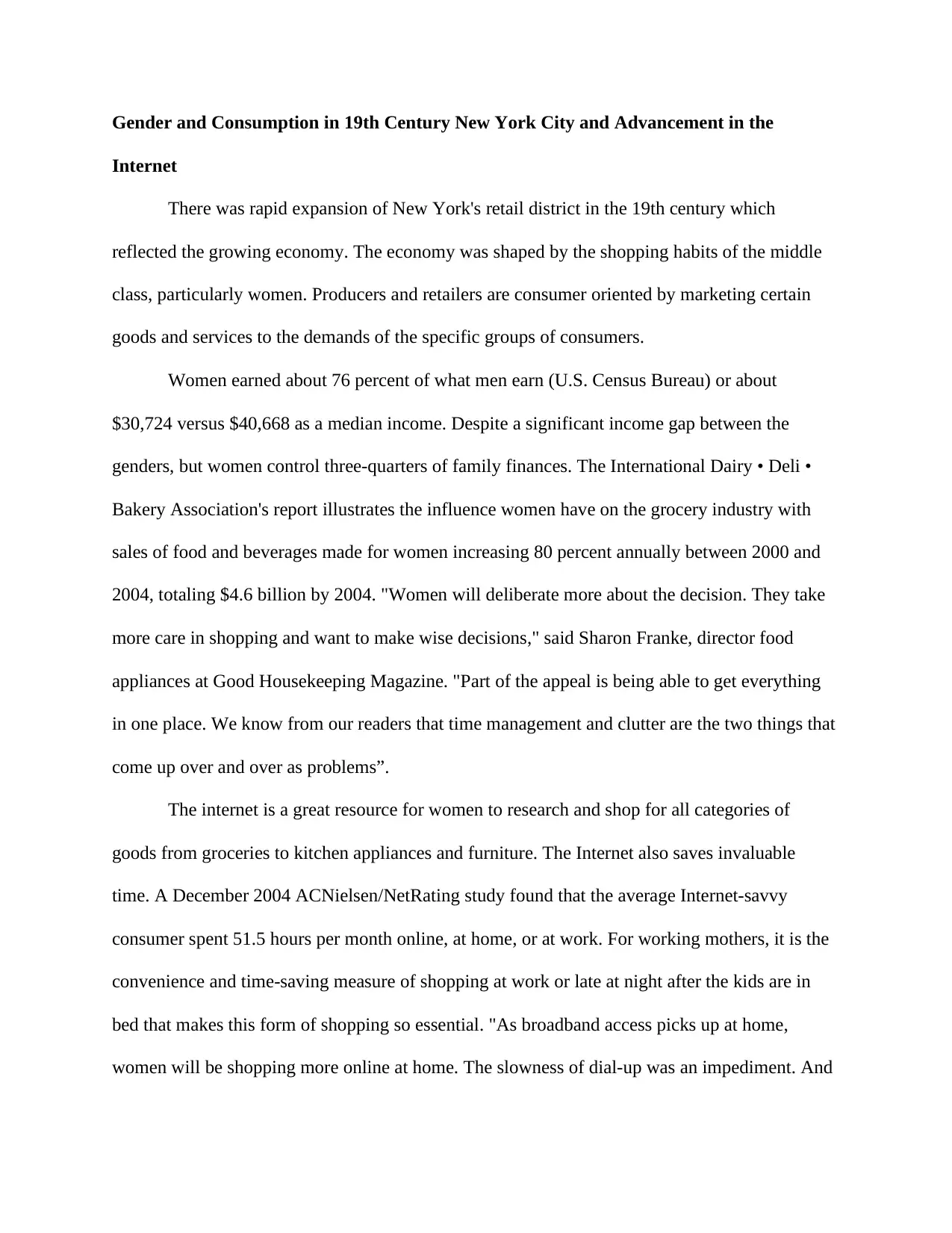
Gender and Consumption in 19th Century New York City and Advancement in the
Internet
There was rapid expansion of New York's retail district in the 19th century which
reflected the growing economy. The economy was shaped by the shopping habits of the middle
class, particularly women. Producers and retailers are consumer oriented by marketing certain
goods and services to the demands of the specific groups of consumers.
Women earned about 76 percent of what men earn (U.S. Census Bureau) or about
$30,724 versus $40,668 as a median income. Despite a significant income gap between the
genders, but women control three-quarters of family finances. The International Dairy • Deli •
Bakery Association's report illustrates the influence women have on the grocery industry with
sales of food and beverages made for women increasing 80 percent annually between 2000 and
2004, totaling $4.6 billion by 2004. "Women will deliberate more about the decision. They take
more care in shopping and want to make wise decisions," said Sharon Franke, director food
appliances at Good Housekeeping Magazine. "Part of the appeal is being able to get everything
in one place. We know from our readers that time management and clutter are the two things that
come up over and over as problems”.
The internet is a great resource for women to research and shop for all categories of
goods from groceries to kitchen appliances and furniture. The Internet also saves invaluable
time. A December 2004 ACNielsen/NetRating study found that the average Internet-savvy
consumer spent 51.5 hours per month online, at home, or at work. For working mothers, it is the
convenience and time-saving measure of shopping at work or late at night after the kids are in
bed that makes this form of shopping so essential. "As broadband access picks up at home,
women will be shopping more online at home. The slowness of dial-up was an impediment. And
Internet
There was rapid expansion of New York's retail district in the 19th century which
reflected the growing economy. The economy was shaped by the shopping habits of the middle
class, particularly women. Producers and retailers are consumer oriented by marketing certain
goods and services to the demands of the specific groups of consumers.
Women earned about 76 percent of what men earn (U.S. Census Bureau) or about
$30,724 versus $40,668 as a median income. Despite a significant income gap between the
genders, but women control three-quarters of family finances. The International Dairy • Deli •
Bakery Association's report illustrates the influence women have on the grocery industry with
sales of food and beverages made for women increasing 80 percent annually between 2000 and
2004, totaling $4.6 billion by 2004. "Women will deliberate more about the decision. They take
more care in shopping and want to make wise decisions," said Sharon Franke, director food
appliances at Good Housekeeping Magazine. "Part of the appeal is being able to get everything
in one place. We know from our readers that time management and clutter are the two things that
come up over and over as problems”.
The internet is a great resource for women to research and shop for all categories of
goods from groceries to kitchen appliances and furniture. The Internet also saves invaluable
time. A December 2004 ACNielsen/NetRating study found that the average Internet-savvy
consumer spent 51.5 hours per month online, at home, or at work. For working mothers, it is the
convenience and time-saving measure of shopping at work or late at night after the kids are in
bed that makes this form of shopping so essential. "As broadband access picks up at home,
women will be shopping more online at home. The slowness of dial-up was an impediment. And
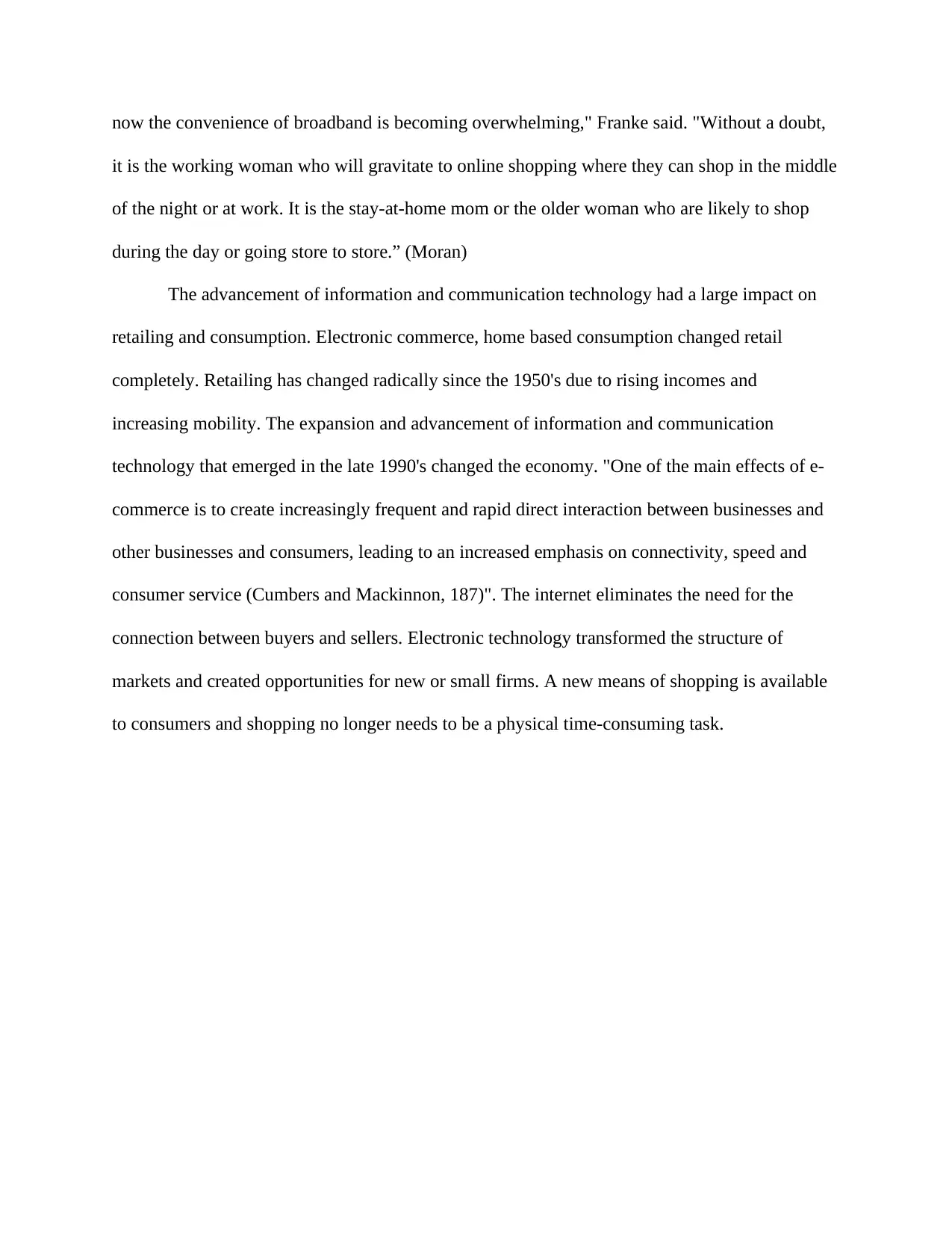
now the convenience of broadband is becoming overwhelming," Franke said. "Without a doubt,
it is the working woman who will gravitate to online shopping where they can shop in the middle
of the night or at work. It is the stay-at-home mom or the older woman who are likely to shop
during the day or going store to store.” (Moran)
The advancement of information and communication technology had a large impact on
retailing and consumption. Electronic commerce, home based consumption changed retail
completely. Retailing has changed radically since the 1950's due to rising incomes and
increasing mobility. The expansion and advancement of information and communication
technology that emerged in the late 1990's changed the economy. "One of the main effects of e-
commerce is to create increasingly frequent and rapid direct interaction between businesses and
other businesses and consumers, leading to an increased emphasis on connectivity, speed and
consumer service (Cumbers and Mackinnon, 187)". The internet eliminates the need for the
connection between buyers and sellers. Electronic technology transformed the structure of
markets and created opportunities for new or small firms. A new means of shopping is available
to consumers and shopping no longer needs to be a physical time-consuming task.
it is the working woman who will gravitate to online shopping where they can shop in the middle
of the night or at work. It is the stay-at-home mom or the older woman who are likely to shop
during the day or going store to store.” (Moran)
The advancement of information and communication technology had a large impact on
retailing and consumption. Electronic commerce, home based consumption changed retail
completely. Retailing has changed radically since the 1950's due to rising incomes and
increasing mobility. The expansion and advancement of information and communication
technology that emerged in the late 1990's changed the economy. "One of the main effects of e-
commerce is to create increasingly frequent and rapid direct interaction between businesses and
other businesses and consumers, leading to an increased emphasis on connectivity, speed and
consumer service (Cumbers and Mackinnon, 187)". The internet eliminates the need for the
connection between buyers and sellers. Electronic technology transformed the structure of
markets and created opportunities for new or small firms. A new means of shopping is available
to consumers and shopping no longer needs to be a physical time-consuming task.
⊘ This is a preview!⊘
Do you want full access?
Subscribe today to unlock all pages.

Trusted by 1+ million students worldwide
1 out of 32
Your All-in-One AI-Powered Toolkit for Academic Success.
+13062052269
info@desklib.com
Available 24*7 on WhatsApp / Email
![[object Object]](/_next/static/media/star-bottom.7253800d.svg)
Unlock your academic potential
Copyright © 2020–2025 A2Z Services. All Rights Reserved. Developed and managed by ZUCOL.
